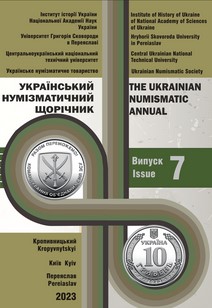KINGDOM OF KARTL-K‟AKHETI VS. CAUCASIAN KHANATES: PECULIARITIES OF MONETARY POLICY IN THE 2ND HALF OF THE 18TH CENTURY – EARLY 19TH CENTURY
KINGDOM OF KARTL-K‟AKHETI VS. CAUCASIAN KHANATES: PECULIARITIES OF MONETARY POLICY IN THE 2ND HALF OF THE 18TH CENTURY – EARLY 19TH CENTURY
Author(s): Irakli PaghavaSubject(s): Economic history, Economic policy, Government/Political systems, 18th Century, 19th Century
Published by: ДВНЗ Переяслав-Хмельницький державний педагогічний університет імені Григорія Сковороди
Keywords: monetary policy; Caucasus; Kartli-Kakheti kingdom; coins;
Summary/Abstract: We researched the monetary policy pursued by the monarchs of the south-east-Caucasian polities nascent in the 2nd half of the 18th century, after the murder of Nāder Shāh, and lasting through the 1st quarter of the 19th century, when they were one by one either annexed by the Russian Empire or Qājār Iran. We concentrated upon the general numismatic history of the region, rather than the coin type sequences issued locally. From methodological point of view, we considered it promising to conduct the comparative analysis of the monetary policies pursued by the polities classified into two major groups according to the ethnicity and religion of the ruling elite (and population, to an extent): 1) the Kingdom of Kartl-K‘akheti (henseforward, KKK), a national Georgian state with predominantly Christian and Georgian population, ruled by Christian Georgian kings; and, 2) khanates governed by Muslim (mostly Turkic) rulers, with mixed population comprising various, mostly (Shī‗a and Sunni) Muslim, but also Christian (Georgian, Udi, and Armenian) ethnic groups. Our article is divided into three major sections: 1) Descriptive, comprising four subsections (Producing the coinage, Designing the coinage, Manipulating the coinage, and Controlling the coin market); 2) Analytical, researching the underlying factors predetermining and affecting the monetary policy pursued by the local rulers; and 3) Qualificatory, in which we attempt to evaluate its efficacy. We came to a conclusion that differences in monetary policy of the KKK and khanates authorities could be foredestined by 1) The economic geography of the region (availability vs. presumably limited supply of the traditional coin metals in correspondingly the KKK and khanates; involvement in international trade, i.e. location with regard to trade routes; extent of territory and population); 2) The local minting traditions and paradigm (centuries long tradition and technical expertise of striking coins manually at some of the local mints, farmed out; retaining Ṣafavīd triadic system of coinage; historical memory of renovatio monetae and weight reductions); however, local rulers also employed novel methods for gaining more profit, like debasing the alloy as a state policy, or countermarking the coins; 3) The omnipresent foreign threat, precluding local rulers from appropriating the right of sikka, and forcing them to acknowledge the prevailing foreign overlord, or issue posthumous or anonymous, frequently immobilized coinage; 4) The mindset of the local monarchs, specifically their adherence to historical and national tradition, obvious in case of the KKK, but not the khanates. The majority of the Caucasian polities pursued some active monetary policy, issuing their own currency, predominantly in silver and copper (the latter also being an integral part of their monetary policy and monetary heritage). Even the khanates operating no mint, or minting coins only during the limited period of time, had to deal with the money circulation on their territory. The meta-analysis of the hoards makes it clear that the KKK and khanates were capable of saturating at least the local economy with their coinage; Irak‘li II of KKK even managed to regulate the monetary market in his realm. Farming out the mint provided the king of the KKK with annual (?) income of up to 500 tūmāns (in the 1790s); in the khanates the figure would be comparable, or less. In the KKK the authorities more or less successfully converted their copper coinage into a powerful mass-media outlet aggrandizing the Georgian monarch and disseminating Christian iconography. Both the KKK kings and khans manipulated the coinage minted and circulating locally in many different ways (by altering or immobilizing the weight and silver standards as well as the general design; countermarking; restriking; renovating the coinage) in order to gain more profit. However, it is hard to say whether this policy was reasonable in the long run. Further studies would hopefully further elucidate the monetary policy pursued by the local monarchs. Nevetheless, it is already clear that the currencies issued, and circulating in south-eastern Caucasus in the 2nd half of the 18th century – 1st quarter of the 9th century constitute a powerful tool for researching various issues of regional history. The relatively short story of the KKK and khanates ended in Russian conquest; however, that was an instructive and consequential phase in the history of the region and its population, albeit an abortive one. Consequently, the numismatic history of the local 18th-19th c. polities gains particular significance.
Journal: Український Нумізматичний Щорічник
- Issue Year: 2023
- Issue No: 7
- Page Range: 161-192
- Page Count: 32
- Language: English

